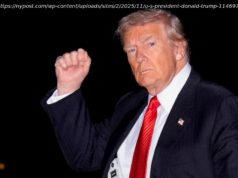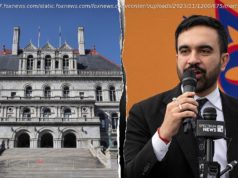Debunking the strangely popular myth that Trump is not a Republican.
After spending months governing as a hard-right conservative, President Donald Trump made his first real reach across the aisle last week — coming to an agreement with congressional Democrats to raise the debt limit for three months. This one example of bipartisanship has led several of America’s leading political journalists to come to a sweeping conclusion: Trump is no longer a Republican. This theme appeared in a spate of pieces — from the New York Times, the Washington Post, and the Associated Press — published over the course of the weekend.
“Mr. Trump has shown in the nearly eight months in office that he is, in many ways, the first independent to hold the presidency since the advent of the current two-party system around the time of the Civil War, ” the Times’ Peter Baker wrote on Saturday, in the piece that best exemplified the budding genre.
This represents, at best, a complete loss of perspective on the Trump presidency.
A look at the past eight months of policymaking reveals an administration pursuing a pretty much down-the-line conservative agenda, about as far from attempting to govern in an independent and bipartisan fashion as could be on most issues.
The “Trump as independent” genre also fails on a deeper level. It assumes that the Republican Party is somehow distinct from Trump, that the chaos and cruelty that’s characterized the current administration can be cleanly separated from the Republican Party as an institution. But it cannot: Trump is a product of a kind of white identity politics that makes the Republican Party a viable force today. In this sense, he is arguably a more authentically Republican politician than the congressional leaders he’s clashed with.
It’s easy to point to Trump’s rhetorical heresies — his tweets criticizing Republican leadership, his musings about withdrawing from free trade agreements, his distrust of the so-called “establishment” — as signs of non-Republicanism. Such things represent the core of the case for seeing Trump as an independent.
“In recent weeks, he has quarreled more with fellow Republicans than with the opposition, blasting congressional leaders on Twitter, ousting former party officials in his White House, embracing primary challenges to incumbent lawmakers who defied him and blaming Republican figures for not advancing his policy agenda, ” Baker writes.
It doesn’ t really matter what Trump says, though, if it’s not paired with policy.
No one would seriously argue that Barack Obama wasn’ t a Democrat because he repeatedly attempted to get bipartisan support for legislation, or strike deals with Republicans on the debt ceiling. Obama is universally remembered as a Democrat because of the D next to his name and because he pursued Democratic policy priorities, like expanding access to health care, while in government.
Donald Trump obviously has an R next to his name. And, like Obama, he has vigorously and consistently pursued his party’s policy priorities — like slashing tax rates, scaling back government regulations in a number of different sectors of the economy, and pushing more conservative approaches on social issues.
The Trump administration has ordered a ban on transgender individuals serving in the military, started repealing DACA, and withdrawn from the Paris climate agreement. The president has ordered an end to Obama administration’s Clean Power Plan, moved to scale back regulations on Wall Street, and loosened federal restrictions on gun sales.
Trump’s major legislative accomplishment is getting party-line conservative Neil Gorsuch appointed to the Supreme Court. The White House spent months working with Republican leaders to try to get some kind of Obamacare repeal over the finish line, and failed only by a single vote in the Senate. He’s now urging Congress to pass “tax reform, ” a fancy way of saying tax cuts for the rich, which is, of course, a top priority of Republican congressional leaders as well.
In the past two weeks alone, the Trump administration has rolled back both Title IX rules designed to encourage victims of sexual assault on college campuses and a ban on providing surplus military hardware to local police imposed after the Ferguson protests.
One deal with Democrats on the debt ceiling — an issue that had to be resolved or else the economy would collapse — doesn’ t wipe all of this away. Plenty of presidents have made one-off deals with the opposition party and gone after members of their own party in Congress. Baker himself admits this.
“Franklin D. Roosevelt sought to oust conservative Democrats who bucked him during party primaries in 1938, ” he writes. “ Ronald Reagan worked with Democrats, who controlled the House, to pass his agenda.”
These examples are pretty devastating for Baker’s thesis. Roosevelt and Reagan are, respectively, the paradigmatic examples of modern Democratic and Republican presidents: Each of these two men set the template for what their party stood for that future leaders would follow. That’s because their policy, not their rhetoric, defined their administration’s legacy.
“Presidents have been disowned by their own party before [and] evidence of Trump acting as an independent is light and quite recent, ” Kevin Kruse, a historian of American politics at Princeton University, tweeted after reading Baker’s piece. “In the end, this seems like the 1,834th installment of ‘Look, Trump is Pivoting!’ And just as likely to stand up over time as all the rest.”
The case for Trump being a uniquely independent president — remember, Baker said that this was the first president of this kind since the Civil War — comes down to difficult relations between the president and his party’s congressional delegation, which are hardly unprecedented, and one limited deal with Democrats.
The case for Trump being a Republican comes down to him winning the Republican presidential primary, winning the presidency on the Republican ticket, appointing Republicans to staff his Cabinet and White House, and then pursuing Republican policy goals with the backing of Republican leaders in Congress.
There’s a deeper problem at work here, one that goes beyond a few acute cases of historical and political amnesia.
If there’s anything distinctive about President Trump’s politics, it’s not any kind of penchant for bipartisanship. It’s his willingness to nakedly employ the politics of racial grievance and white supremacy.
Two of the times when the Trump administration most clearly forged its own path were the implementation of ban on travel from several Muslim-majority countries and the president’s response to the white nationalist rally in Charlottesville. These were both situations where Trump wasn’ t really acting on longstanding Republican policy ideas: The Muslim ban was something his campaign came up with, and the Republican leadership mostly opposed Trump’s refusal to single out white supremacists as responsible for violence in Charlottesville (a refusal that has real consequences) .
But Trump won the backing of Republican voters on both of these issues: 84 percent of Republicans support Trump’s travel ban, per Morning Consult, and 67 percent approved of his handling of Charlottesville (per CBS News) .
The two areas where Trump’s so-called “independent” streak most clearly tracked with his behavior weren’ t areas in which he reached out to Democrats. They were when he positioned himself to the ethno-nationalist right of Republicans in Congress.
It’s easy to confuse this contrast with genuine independence from party. But it really speaks to Trump’s ability to identify feelings among a large percentage of the Republican base and manipulate them for his own political gain.






